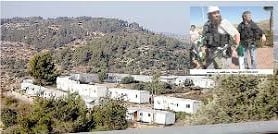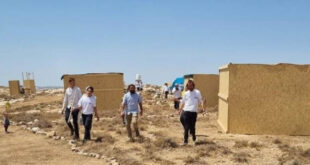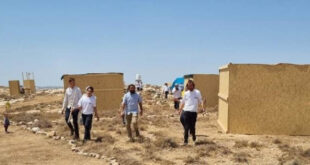By: Madeeha Al-A’raj
Thenational Bureau for Defending Land and Resisting Settlements stated in its latest weekly report , that at the beginning of the New Year, the ‘Israel Hayom Newspaper’,close to Israeli PM Netanyahu, published a report on settlements in the West Bank, under the title: ‘2024 marked the yearof buildingSmotrich’s State in the West Bank’. Indeed, the West Bank witnessesa series of vast transformations to draw a new scene on the ground since the formation of the Israeli Government headed by Netanyahu in partnership with Smotrich and Ben-Gvir, who are trying to confine the Palestinians in isolated enclaves surrounded by settlements, outposts, and so-called pastoral farms from all sides.
The transformations began as of the first day of the formation of the most extremist government in the history of the occupying state, and worsened throughout the year 2024, where settlements strengthened more compared to 2023, after the Israeli government took a set of measures that accelerated the pace of settlements and gave priority to expanding them, as Minister of Settlement in the Ministry of Army Smotrich considers that a strategic goal to erase the Green Line, according to the latest declaration he announced during a visit to one of the 90 farms in the West Bank.Days before the end of 2024he decided to allocate budgets to the pastoral sector in the West Bankfrom the Israeli Ministry of Agriculture.
Many measures have been taken by the occupation authorities to deepen and expand settlements of which was the creation of a special and independent administration in the Civil Administration of Settlements under the supervision of Smotrich to accelerate the construction process in the settlements and transform a number of them into settlement cities. His administration began implementing more flexible and effective procedures to develop the settlements by overcoming the so-called bureaucratic obstacles. This was accompanied by the political changes introduced by the occupation government in June 2023, after it cancelled the requirement for the Minister of Army’s approval at every stage of moving forward with settlement plans and bypassed the so-called Supreme Planning Council meeting only four times a year by holding its meetings weekly to approve the promotion of hundreds of housing units at each meeting, and the resulting adoption by the occupation government of the settlers’ demands regarding resolving the “battle for complete control over Area C”, and treating it as if it were Israeli land.
Moreover, the settler leaders began planning to displace the Palestinians through the rapid expansion of the spread of settlement outposts and pastoral farms on the widest scale in the area C and expanding towards Area B. The expansion of these farms actually began last year, exceeding seven new ones, five of which were established in Area B in the areas south and east of the settlements of Tekoa, Nokdim, Ma’ale Amos, and Asfar, after the settlers paved roads, built observation posts, and began establishing a number of settlement outposts, as also happened with Kumi Ori near Yitzhar, south of Nablus, Ma’ale Rehavam, east of Bethlehem, Havat Gilad, west of Nablus, and others, accompanied by demolishing more Palestinian citizens’ buildings.
Noting that under the 1995 interim agreement between Israel and the Palestine Liberation Organization, Area B was designated as an area under full Palestinian civil control (including planning and building), with Israeli security control. For years, successive Israeli governments refrained from establishing settlements or outposts in areas under Palestinian control. While there were isolated cases of outposts expanding to the edges of Area B, they were usually dismantled by the Civil Administration shortly after their establishment. But in the past year, law enforcement operations against outposts in Area C have virtually ceased, and only one outpost, Or Nachman, north of the Turmusaiya town, was evacuated by the Civil Administration, but settlers immediately re-established it.
According to a report recently published by the newspaper ‘Israel Hayom’, stated that the pace of settlement construction has accelerated to 30,000 housing units in the last two years, with plans to implement other settlement projects, reflecting ‘the Israeli government’s commitment to expanding the presence of settlements in a rapid and sustainable manner’ according to the coalition agreements concluded by the Likud party, led by Netanyahu, with Smotrich, leader of ‘Religious Zionism’.
This was accompanied by improving the settlement infrastructure, as the Israeli government worked to improve the road and transportation network within the settlements and expand and pave the main roads, especially those connected to Route 60, which crosses the West Bank from the far north to the far south, facilitating movement between the settlements and strengthening their connection across the Green Line to the occupying state, in addition to energy projects in the West Bank, which include establishing power stations in the West Bank, in addition to projects in the Jordan Valley area to secure future energy needs and to strengthen the settlement infrastructure throughout the year 2024. The focus here was on the ‘Benjamin areas’ extending between Nablus and Ramallah along Route 60 and the Jordan Valley, as well.
The right-wing newspaper Israel Hayom described what happened in 2024 as the completion of the construction of the pillars of what can be called ‘Smotrich’s state’ in the West Bank, where the Religious Zionism Party’s settlement program was implemented at an accelerated pace. This program aims to impose complete control over the West Bank, including the seizure of large areas of land and the displacement of large numbers of Palestinians, especially after the so-called head of the Central Command, Avi Balut, signed an order allowing for the first time the implementation of settlement urban renewal projects in the West Bank, that allows the construction of 10,000 housing units in the settlements within one year.
The “Smotrich State” in the West Bank found broad support with the appointment last August of General Avraham Avi Balut as commander of the Central Command in the Israeli army, noting that the Israeli army consists of four central commands: the Northern Command, the Central Command, the Southern Command, and the Home Front Command. The Central Command occupies a special position as it plays several roles simultaneously as the “sovereign” in the West Bank, as an occupying power, and supervises civil affairs by heading bodies, such as, the Coordinator of Government Activities in the Territories and the Civil Administration, and enjoys legislative, judicial, and executive powers in the territory it occupies.
The appointment of Avi Balut came to strengthen the joint works between the military and civilian institutions of the occupation in the West Bank, which had been somewhat faltering when General Yehuda Fuchs was the commander of the Central Command due to a dispute over powers and responsibilities with the settler leaders. With the appointment of Avi Balut to this position, there is nothing to disturb the relationship with the settlers or with the Minister of Settlement in the Ministry of Army Smotrich, as the two men belong to the same religious Zionist camp. Avi Balut, the well-known settler, assumed the duties of the military governor of the West Bank, combining in his hand the roles of the three authorities: legislative, executive, and judicial.
Alongside, Smotrich, who is responsible for directing huge budgets to support the settlements, in addition to appointing extreme right-wing figures to senior positions in the Civil Administration, such as, Hillel Roth (Deputy Head of the Civil Administration). Both men are followers of the ultra-Orthodox Rabbi Eli Sedan, founder of the Bnei David Military Religious school, who played a major role in shaping the ideological orientations of both Smotrich and Ballut. The school is one of the most prominent ideological hotbeds of the religious Zionist movement, which seeks to integrate religious people into the ranks of the Israeli army, and push them towards leadership positions.
New developments in the settlement scene in 2024, the effects and repercussions of which on the settlement scene in the West Bank, which is controlled by Smotrich, should not be underestimated, as General Avi Balut, Commander of the Central Command, signed an unprecedented order that allows for the first time the implementation of settlement urban renewal projects in the West Bank, which constitutes a major shift in Israeli policies, as it enhances the so-called legal equality between the lands located within the Green Line and the occupied lands in the West Bank, with regard to settlement planning without the need for the approval of the Central Planning Office for Settlement, and thus paving the way for the construction of thousands of new housing units in the settlements.
Inaddition to the annexation of the West Bank to the jurisdiction of the Israeli Ministry of Agriculture, which adopted the strategy of ‘pastoral settlement’, to complete the picture and under which control was achieved over large areas of Palestinian lands, after the number of these farms in 2024 exceeded about 90 farms, controlling about 650,000 dunams, or about 12% of the area of the West Bank. The extended areas controlled by these settlement outposts these days are now equal, according to Israeli sources, to the area of the Dimona, Jerusalem, Beersheba, Arad, and Eilat cities.
Moreover, the decision of the Minister of the Occupation Army, Yisrael Katz, on Nov. 22 to stop issuing administrative detention orders against terrorist settlers, who carry out attacks on Palestinian citizens in the occupied West Bank, was considered an encouragement to settlers to commit more crimes against Palestinians, especially after the Minister of National Security, Ben-Gvir’s issuing about 38 new weapons licenses after Oct. 7, 2023. This decision by Katz is explained by judicial officials as giving them a “license to kill,” and is likely to “encourage the operations of secret organizations to attack Palestinians and set the region on fire.”
Katz’s decision was based on a hateful racist background that did not take into account the fact that there are about 3,500 Palestinian administrative detainees in the occupation’s prisons. It reflects a lack of responsibility in dealing with the violations of the settlers, who, according to the United Nations Office for the Coordination of Humanitarian Affairs (OCHA), committed about 1,400 attacks against Palestinians in 2024, resulting in 18 martyrs, hundreds of injuries, severe damage to property, and the displacement of 28 Palestinian communities. A report published by Yedioth Ahronoth in June 2023, prepared by its correspondent Elisha Kimon, confirmed that there is a direct relationship between ministers in Benjamin Netanyahu’s government and Jewish terrorists, who carry out mass attacks on Palestinian villages and towns in the West Bank.
At the beginning of the new year, the occupation authorities was the seizure of more than 262 dunams of land from the Jaba, Al-Ram, Kafr Aqab and Mikhmas towns in the Jerusalem Governorate to expand the settlement road 45 that extends from Mikhmas to the new tunnel under Qalandia Airport. In this regard, the Israeli human rights organization ‘Ir Amim’ revealed that the occupation government is seeking to annex lands from the village of Jaba to be controlled by the ‘Geva Binyamin’ settlement, after the settlers seized them and forced the Palestinian citizens to leave.
The citizens of the Jaba’ village, in cooperation with the organization ‘Bimkom – Planning and Human Rights’ and the organization ‘Yesh Din – Yohaj Law’, submitted an urgent objection to the Civil Administration’s announcement issued on Dec. 9, 2024 regarding its intention to expand the area. Noting that the lands that the Civil Administration intends to seize include the ‘Sneh outpost’ (Bnei Adam), which was built on public and private land owned by Palestinians, and extends beyond the scope of the planned expansion. If they did so, they will create two enclaves of private Palestinian land within the settlement’s jurisdiction, which will prevent the landowners from freely accessing their property.
List of Israeli Assaults over the Last Week Documented by the National Bureau:
Jerusalem:
– Storming the Al-Aqsa Mosque under the protection of the occupation police, headed by extremist Rabbi Yisrael Shalita, more than 600 settlers conducted provocative tours and performed Talmudic rituals in its courtyards, coinciding with the occupation police tightening its measures in the Old City and at the gates of Al-Aqsa and preventing worshipers from entering the mosque.
– Forcing owners of 6 houses belonging to the Awida family to demolish their homes under the pretext of not having a permit in Silwan town.
– Demolishing order of a number of other houses and facilities in the Jabal al-Mukaber, the occupation bulldozers demolished a house belonging to the citizen Widad Halsa, and bulldozed the road leading to it in the town.
– Demolishing a barn and a sheep pen in the Mikhmas village, and bulldozed a road in the village. Meanwhile, they forced the citizen Shadi Samreen to demolish his house in Wadi al-Rababa neighborhood in the Silwan town under the pretext of building without a permit.
Hebron:
– Attacking the house of citizen Farid Al-Hamamdeh in the Fateh Sidra area, provoked and insulted the family with offensive and obscene words.
– Assaulting a number of farmers by beating them in the Asfi and Maghayer Al-Ubaid villages, including: Mah’d Rasmi Makhamreh, Fadl Musa Makhamreh, Salah Shahada Makhamreh, and Yousef Muhammad Awad, and prevented them from plowing their lands and planting them with winter crops.
– Storming the village of Al-Buwaib, east of Yatta, and fired live bullets and assaulted residents, farmers, and citizens, which led to the injury of a number of citizens, including a father and his son, Mahmoud Ibrahim Al-Jundi and his son Muhammad, with bruises and fractures, before they were arrested by the occupation army.
– halting construction on a house under construction belonging to citizen Ayed Abu Taha, located in the Um al-Shaqhan area in Khallet al-Mayyeh, east of Yatta, photographed the house of citizen Hazem Mahmoud Abu Taha, who had previously received a notification to halt work on his house in the same area.
Bethlehem:
– Cutting down olive trees in the Battir town. Citizen Omar Al-Qaisi confirmed that settlers stormed his land in the ‘Al-Khamar area’, and cut down 6 olive trees and an apple tree, after they uprooted part of his land fence.
– Establishing a new pastoral settlement outpost in the Nahalin town’s lands, where they installed two large barns for raising livestock on the lands of the ‘Ein Fares area’, west of the town, located between the ‘Beitar Illit settlement’, the Wadi Fukin village, and Al-Jabaa, in preparation for the establishment of a large settlement outpost.
Ramallah:
– Storming the archaeological area of Al-Burj in the Sinjil town.
– Seizing d 6 tents and an agricultural room in the Al-Mughayir village after forcing their owners to leave by force. They continued their attacks on the village and burned agricultural rooms belonging to citizens from the neighboring village of Abu Falah and the Turmusaiya village, while the occupation forces stationed at the eastern entrance of the village to provide protection for the settlers.
– Bulldozing lands near the Mikhmas village, northeast of the occupied Jerusalem. Settlers had established the “Sde Yonatan” settlement outpost, adjacent to the “Ma’ale Mikhmas” settlement, on citizens’ lands in the village, and they use the outpost as a starting point to carry out their attacks on citizens’ lands and property.
– Attacking farmers in Silwad town, west of the town near the settlement outpost in Al-Burj. A number of young men rushed to rescue the farmers from the settlers, which resulted in the injury of 9 citizens.
– Openinga Jewish synagogue in the presence of the most senior Jewish rabbis in the settlement outpost ‘Oz Zion’, which was built on the lands of the Burqa town, east of Ramallah.
Nablus:
– Forcing the residents of Khirbet Tana, east of Nablus to evacuate, fired live bullets, sound bombs, and tear gas at their homes, forcing 12 families to evacuate.
– Establishing a new settlement outpost on the in the Qaryiot village’s lands, where they set up tents in the “Silon” area.
– Attacking houses in the Salem village, and attacked the houses and vehicles in the Burin village.
– Paving a new settlement road on the road to link the Allon settlement road and the new settlement outpost that the settlers established after the war on the Gaza Strip on the lands of Khirbet Tana.
Qalqilia:
– Torching a vehicle belonging to Raed Basalat in the Hajja village.
– Attacking citizens’ homes with stones in the Farata and Amatin villages, east of Qalqila, damaged their windows and destroyed their crops.
Salfet:
– Demolishing a nursery and a car-wash room on an area of two dunams in the Marda village under the pretext of neing close to the Ariel settlement, belonging to Moh’d Mansour.
– Demolishing two inhabited houses, belonging to the brothers Moataz and Tariq Talab Dheeb, each of which was 200m2, and retaining walls surrounding the houses.
Jenin:
– Seizing agricultural land in the Jaba town, south of Jenin. The landowner, Saad Fashafsheh, said that settlers stormed his agricultural land near the village of Al-Fandaqumiya with their agricultural machinery and began plowing and cultivating the land with the aim of seizing it, under the protection of the occupation army.
Jordan Valley:
– Destroying fodder and property in the Arab Al-Mlihat Community, coincided with the ‘rainfed season’ in the Jordan Valley.
– Plowing scores of dunams of agricultural land in different areas of the northern Jordan Valley and prevented their owners from cultivating them. S
– Fixing caravans on citizens’ lands east of the Tamoun town in the ‘al-Tha’la area’, amid fears that it would later be turned into a settlement outpost.
– Attacking citizens in the Bardala village, and attempted to steal cows belonging to citizen Jamal Abd Sawafta in the western area of the village.

 المكتب الوطني للدفاع عن الارض ومقاومة الاستيطان منظمة التحرير الفلسطينية
المكتب الوطني للدفاع عن الارض ومقاومة الاستيطان منظمة التحرير الفلسطينية



